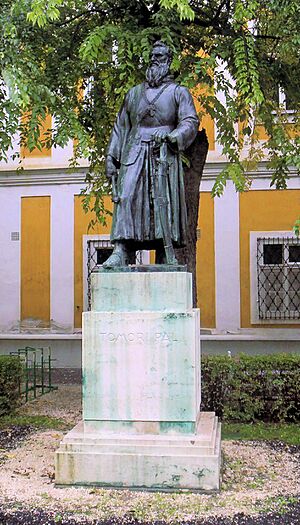Pál Tomori facts for kids
Pál Tomori (born around 1475 – died August 29, 1526) was a brave Catholic monk and an important archbishop in Kalocsa, Hungary. He was also a skilled military leader.
In 1523, he led a Hungarian army that defeated the Ottoman forces near a place called Sremska Mitrovica. This was a big victory for Hungary.
Later, in 1526, Pál Tomori became one of the main commanders of the Hungarian army during the famous battle of Mohács. Sadly, he died in this battle while trying to rally his soldiers.
Contents
Life of Pál Tomori
Pál Tomori was born into a regular family in a county called Abaúj. He started his career in the military working for a noble family. He held various important jobs, like being a clerk and a treasury official. From 1505 to 1514, he was in charge of a castle in Fogaras.
Early Years and Military Career
In 1506, Tomori helped to stop a rebellion by a group called the Szekler, who were upset about a new tax. He also traveled to the Turkish court in 1512 as an ambassador for the Hungarian king.
In 1514, after a big peasant uprising led by György Dózsa, Tomori was sent to fight against the peasant army. In this battle, Tomori defeated the rebels and captured their leader. This battle ended the Hungarian peasant war of 1514.
From 1514 to 1518, he was a castle captain in Fogaras (today Făgăraș) and Munkács (today Mukachevo). Then, in 1518, he became captain of the castle in Buda. In 1519, he helped to stop another rebellion during a parliament meeting.
From Soldier to Monk
Around 1520, for reasons that are not fully known, Pál Tomori decided to change his life. Some people think it was because his bride died. He gave away his wealth to his family and joined a group of Franciscan monks. He went to live in a monastery in Esztergom.
Tomori was known as a very good soldier. So, when a war started between Turkey and Hungary in 1521, many people thought he was the best person to lead the Hungarian armies. People in Buda said that most Hungarian nobles were not ready for war because of a long period of peace. They believed only Pál Tomori was truly skilled in warfare. However, Tomori did not want to return to a military life at first.
Leading the Defense
Finally, the Pope himself, Pope Adrian VI, asked Tomori to accept the role of archbishop of Kalocsa on February 4, 1523. Then, in April, the Hungarian leaders quickly made him the "country's lieutenant and captain of the entire Great Plain." Tomori agreed to these important jobs. He became the main organizer and military leader for Hungary's defense against the Turks.
For three years, he worked hard in the southern parts of Hungary. He greatly improved the border defenses. He arrived at his post in Pétervárad (today Petrovaradin) in July 1523. By August, he had to fight the Bosnian pasha Ferhád, who was leading an army of about twelve thousand men. On August 6 and 7, Hungarian troops won a major victory over Ferhád's army in three battles.
This was the only big Hungarian victory in the Hungarian-Turkish war of 1521–26. For the next year and a half, Tomori worked to make the southern border forts stronger. He used these castles to push back Turkish attacks, which were happening more often. By 1525, he had made the situation so stable that he could even launch attacks into Turkish territory.
He could not plan bigger campaigns because he received very little support from the Hungarian government and lords. Tomori used all the money from his archdiocese to pay for defense. He also received some help from the Pope, but it was not enough for the huge task he faced.
To make the king and the lords understand the danger, he often threatened to quit. On January 12, 1526, he actually resigned. But then, the Ottoman leader Suleiman the Magnificent decided to start another campaign against Hungary. So, Tomori took back his resignation and returned to his post. His plan was to try to stop the Turkish army with about six thousand soldiers.
The Battle of Mohács
On August 24, he defeated a Turkish group. However, the military council ordered his army to join the main Hungarian army. Tomori did not agree with this decision, but he followed the order.
In the battle of Mohács on August 29, 1526, Pál Tomori was the commander-in-chief of the Hungarian armies. The battle was short, and many important church leaders and nobles died. Pál Tomori also lost his life trying to stop fleeing soldiers.
Interesting Stories About Tomori
Many legends and stories are told about Pál Tomori. One story says that his wife was killed, which made him decide to become a monk. Another legend says that he only became an archbishop because his king pressured him. But even as an archbishop, he refused to wear anything but his armor and the monk's cowl (a hooded robe).



